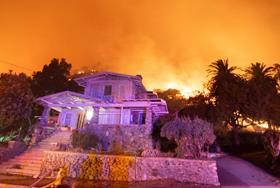Loss of LAs architectural heritage raises questions about urban sprawl and design of timber structures
Thousands of timber-framed structures, including cultural landmarks like the Will Rogers Ranch House and notable examples of architecture such as Ray Kappes Keeler House, have been destroyed as wildfires rage through Los Angeles County, sparking urgent debates on fire-resilient design and the ethics of building in high-risk areasSource: ShutterstockA burnt-down house stands in ruins, a stark reminder of the devastation caused by the Eaton Fire in Altadena, CaliforniaThe devastating wildfires sweeping through California have left a trail of destruction, claiming at least 27 lives, destroying more than 12,300 structures, and forcing thousands to evacuate their homes. Entire communities across Los Angeles County and neighbouring areas have been engulfed, with fires reducing homes, businesses, and landmarks to ashes.Among the losses is the historic Will Rogers Ranch House in Pacific Palisades. Built in 1926, the clapboard residence was once a retreat for Hollywood elites and later became a public park and museum. Today, it lies in ruins after being consumed by the Palisades Fire.Its a completely devastating blow for all of us, Adrian Scott Fine, chief executive of the Los Angeles Conservancy, told the New York Times. Its just a touchstone. You cant hardly talk about Southern California history and the Pacific Palisades without acknowledging this cultural folk hero, Will Rogers.These are profound losses, he added. There are no other places like these that can tell these kinds of stories.The fires have also destroyed the Keeler House, a striking 1991 hillside residence in Pacific Palisades designed by Ray Kappe, founder of SCI-Arc. The architectural loss underscores the vulnerability of many Californian structures, particularly timber-framed and timber-clad buildings, to fast-moving wildfires.Source: ShutterstockThe Eaton fire burns in Sierra Madre, on the east side of Los Angeles, California, 8 January 2025Experts have long warned of such disasters, pointing to the effects of unchecked urban sprawl and, increasingly, the role of climate change. Rising temperatures, prolonged droughts, and extreme weather patterns have created conditions that make wildfires more frequent and intense.Authors such as Mike Davis have critiqued the planning practices that allowed homes to proliferate in high-risk zones, as detailed in works like City of Quartz and Ecology of Fear. Now, these critiques are being joined by urgent discussions about climate resilience, the need for fire-resistant materials, and more sustainable urban planning to mitigate the risks of a warming planet.As firefighters continue their efforts to contain the blazes, the immediate priority remains saving lives and minimising further damage. However, the fires have already reignited debates about stricter building codes, fire-resilient design, and the ethics of continued development in wildfire-prone areas, especially as climate change exacerbates these risks.Timber, a dominant building material in many Californian homes, has proven especially vulnerable, compounding the devastation. The disaster highlights the urgent need for long-term strategies that address not only building practices but also the broader environmental factors driving the increasing frequency of such catastrophes.>> Also read:The rising toll of disasters: why the US needs coordinated national action on climate change


